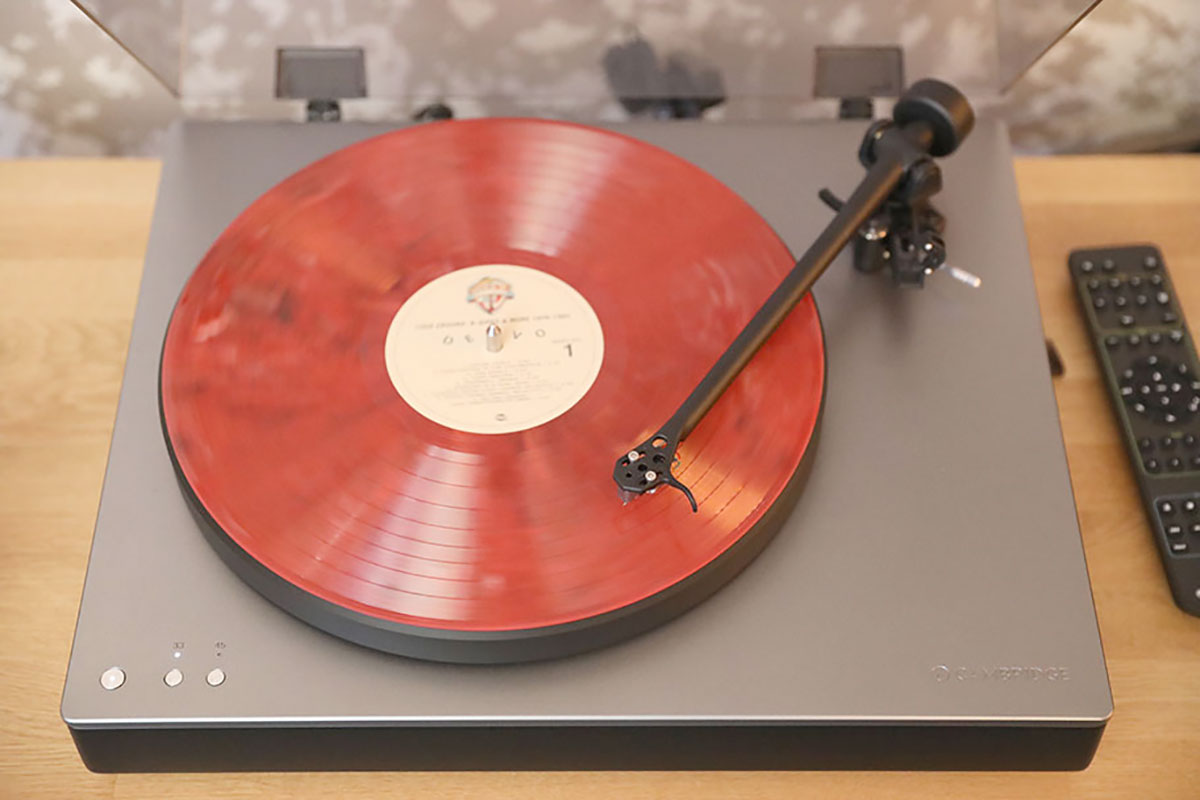
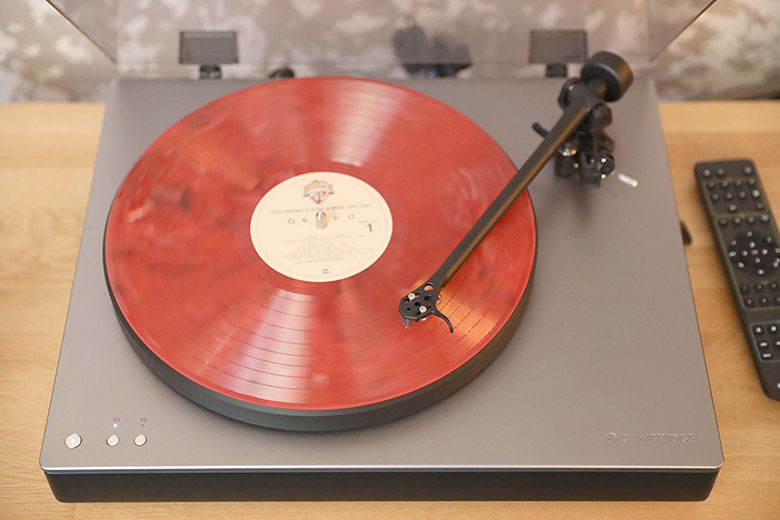
The Master Switch


The Master Switch
Vinyl records deliver music with an elusive and romantic warmth that audiophiles continue to love. You may be the owner of a huge vintage record collection, or you may just choose to enjoy one of those portable, battery-powered record players in the park. Listening to music like this is addictive: the handling of the physical product, marveling at the artwork, and checking out song lyrics and credits in a way you never do with streaming or CDs. It’s a unique experience, and you’ll need a turntable to make the most of it. Below are the best turntables of 2023, and for more background, see our turntable comparison table and buying advice below the picks.
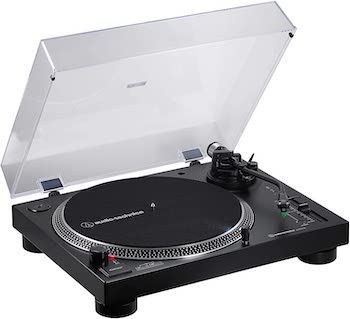 Type: Direct Drive
Type: Direct Drive
Speeds: 33⅓, 45, 78 RPM
Cartridge Included: Yes
Phono Preamp Included: Yes
What We Like: Excellent sound with a good range of features.
What We Don't: Wireless performance isn't spectacular.
Of the thousands of turntables available, we have no doubt that the Audio-Technica AT-LP120XBT is the absolute best for most people. It’s not just the sound, which is clear and clean. It’s the stunning range of features. You get a great phono stage, a USB output, and Bluetooth 5.0. The latter lets you listen to vinyl on your headphones or powered speakers. There's also an included cartridge. We can’t think of another turntable that offers this many features, or packages them together so well.
There is a downside to the Audio-Technica AT-LP120XBT. The wireless audio performance sounds fine, but it loses out to less expensive turntables like the Sony PS-LX310BT. This is despite the inclusion of Bluetooth 5.0. If great wireless performance is your key consideration, go for the Sony. But for everything else, the Audio-Technica takes it. Whether you are just getting started in the world of turntables, or looking for a confident, assured platter for your hi-fi system, the AT-LP120XBT is the one to go for.
See the Audio-Technica AT-LP120XBT
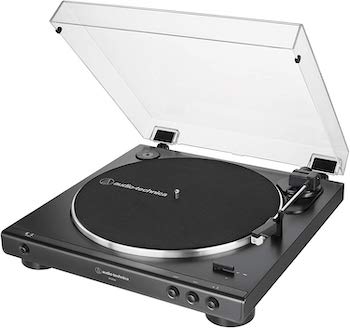 Type: Belt Drive
Type: Belt Drive
Speeds: 33⅓, 45 RPM
Cartridge Included: Yes
Phono Preamp Included: No
What We Like: Solid sound for the money, plug-and-play design.
What We Don't: Dynamic range can be lacking.
A good budget turntable should be easy to set up and use. The Audio-Technica AT-LP60X ticks both of those boxes. It’s as automatic as a turntable can get, even including a feature that senses whether 33⅓ or 45 RPM speed is needed for a particular record. The sound is unspectacular, but still very decent. It easily beats other budget models like the Victrola Journey. There’s a reason why Audio-Technica occupies both of the top spots on our list. It's because when it comes to turntables, there is no one else who can do what they do.
As a budget turntable, the AT-LP60X does have limitations. One of those is the lack of dynamic range, which refers to the ability to reproduce very loud and very quiet sounds. That could be a problem if you enjoy listening to movie soundtracks or classical music. If you want to buy an affordable turntable with a little more subtlety in this area, try the Crosley C6, below. It costs a little more and isn’t quite as easy to use, but it also sounds much better. Note that there’s also a wireless model, the AT-LP60BT. However, we think there are better wireless turntables available—see the Sony PS-LX310BT below, for example.
See the Audio-Technica AT-LP60X
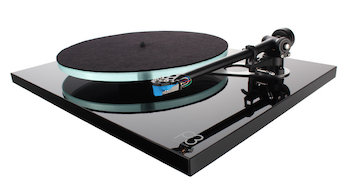 Type: Belt Drive
Type: Belt Drive
Speeds: 33⅓, 45 RPM
Cartridge Included: No
Phono Preamp Included: Yes
What We Like: Great build with sound that is both realistic and immensely fun.
What We Don't: Needs careful tuning and positioning before use.
Rega built their brand by making class-leading (and expensive) turntables. It’s a pleasant surprise that their Planar 3 is relatively affordable for what you get. For a turntable under $1,500 to sound this good is unheard of. The audio quality pulls off a very neat trick, managing to sound both realistic and clean while never losing its sense of fun. It’s a much more enjoyable turntable than the somewhat stuffy Cambridge Audio Alva TT, below. It also helps that the Planar 3 is built like a tank, with a design that matches the price tag. All in all, it’s a superb turntable.
One thing you need to be prepared for is the setup. Like all high-end turntables, you’ll need to spend time balancing the tonearm and setting the tracking weight. For some reason, the Planar 3 can be very demanding here, meaning there’ll be extra time spent on the setup. Even changing speeds requires manually moving the belt! The sound is rewarding, but if you like your turntables to be plug-and-play, there are better options. Think the Music Hall mmf-5.3, below. The model we’ve listed here comes without a cartridge, there’s an option to add an Elys 2 cartridge to the package elsewhere on Amazon. It’s around $200 more expensive, but it will absolutely super-size the sound.
See the Rega Planar 3
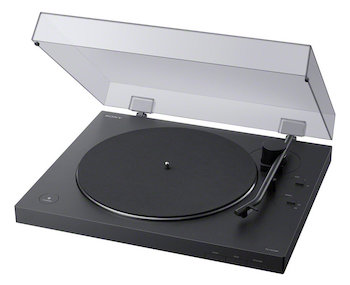 Type: Belt Drive
Type: Belt Drive
Speeds: 33⅓, 45 RPM
Cartridge Included: Yes
Phono Preamp Included: Yes
What We Like: Simple Bluetooth and automatic operation make this turntable a dream to use.
What We Don't: Better-sounding alternatives at this price point.
It’s crazy to us that Bluetooth still isn’t very common in the turntable world. Especially when you consider how well the Sony PS-LX310BT does it. Pairing takes seconds, and it means you can listen to vinyl through wireless headphones or a wireless speaker. Bluetooth audio can sometimes sound tinny and stripped-down, but that’s not a problem here. The audio is crisp and clean, and the PS-LX310BT is incredibly simple to use. We’d compare it favorably with the Audio-Technica AT-LP60X, above. That platter is so simple it practically runs itself.
The Sony PS-LX310BT offers a superb wireless experience, but there are better-sounding alternatives for the price. The Audio-Technica AT-LP120 only costs around $30 more but is light years ahead in sound. Even the $179 Crosley C6, below, arguably sounds better. Neither of those models do wireless, and no model on this list does wireless quite as well as the PS-LX310BT. But it’s far from the best-sounding model here.
See the Sony PS-LX310BT
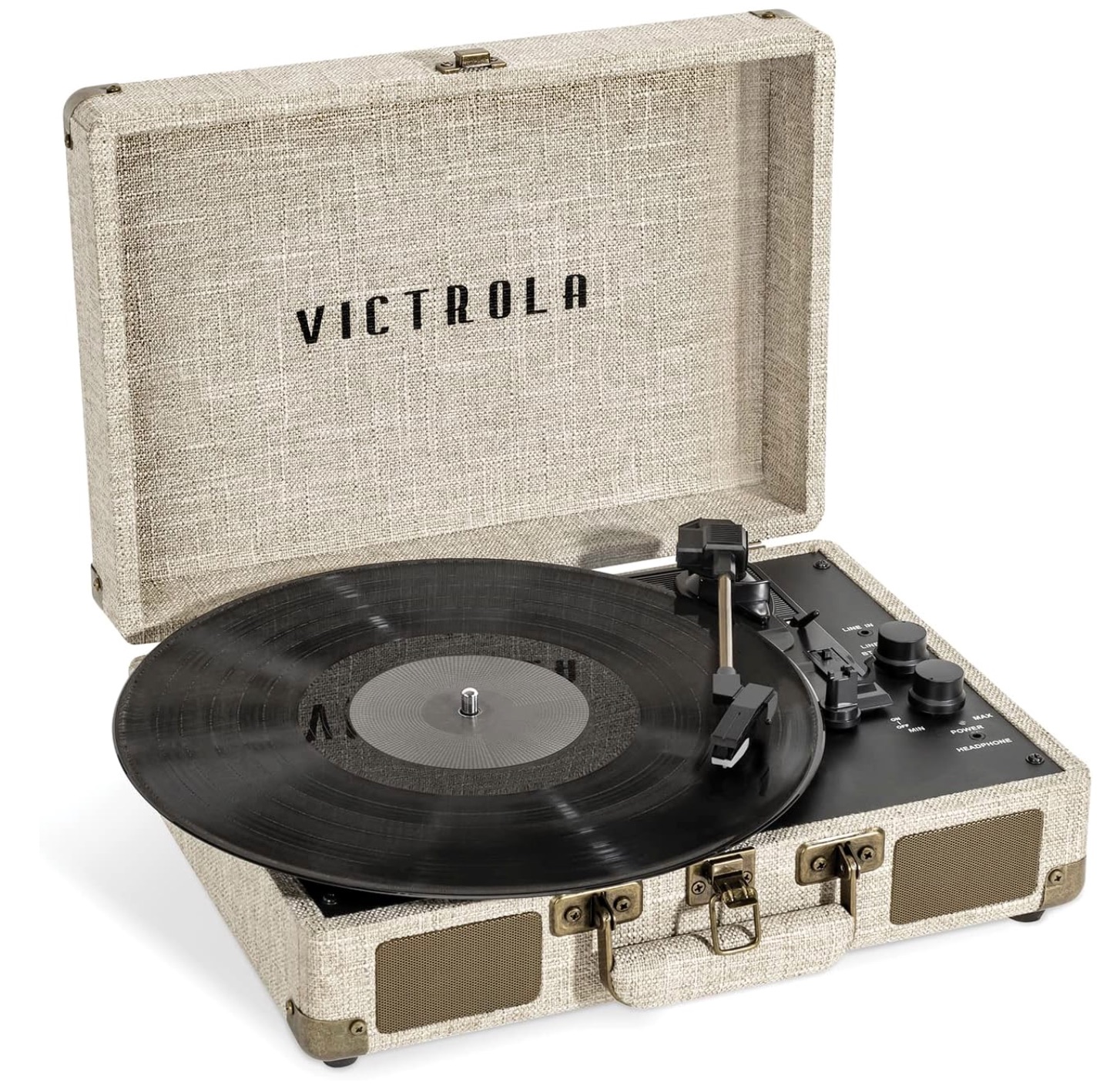 Type: Belt Drive
Type: Belt Drive
Speeds: 33⅓, 45, 78 RPM
Cartridge Included: Yes
Phono Preamp Included: No
What We Like: Portable design with a handy Bluetooth connection, and funky looks.
What We Don't: Other models sound much better.
Vintage turntables have seen a huge resurgence in recent years, and we can see why. Just look at the Victrola Journey. It matches terrific looks with surprising convenience, arriving in a portable suitcase design. If you’re looking for a turntable that both looks good and performs well, we think it’s the best option here. It’s also highly affordable, costing even less than our best budget option, the $119 Audio-Technica AT-LP60X (which, of course, is not portable).
The one thing to note about vintage turntables is that they rarely sound as good as they look. That’s true for the Victrola Journey as well. The sound is capable but can come across as muffled and thin at times. This is especially true when you’re listening over the Bluetooth connection. If you’re looking for a turntable with slightly better sound, try the Victrola Nostalgic. Either that, or spring for the aforementioned AT-LP60X.
See the Victrola Journey+
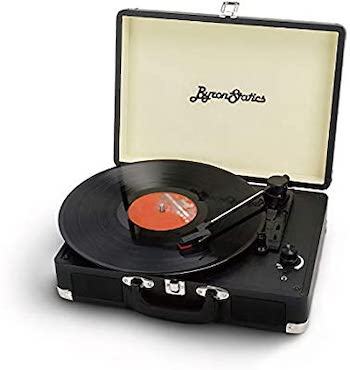 Type: Belt Drive
Type: Belt Drive
Speeds: 33⅓, 45, 78 RPM
Cartridge Included: Yes
Phono Preamp Included: No
What We Like: Great sound for under $50.
What We Don't: Very heavy for a portable turntable.
We don’t usually recommend going for turntables that cost less than around $50. The Byron Statics KCT-601 is an exception, and if you're a beginner, it's perfect. It offers powerful sound, and, like the Victrola turntable, it comes in a self-contained suitcase design. It’s an ideal turntable for grabbing on your way out the door. That's because the metal construction means it can take a few knocks.
One thing to bear in mind is that the KCT-601 is heavy. The Victrola model above weighs 2.69 pounds, but the KCT-01 is nearly triple that at 6.6 pounds. The metal construction may be robust, but you’ll need strength to tote this one around. The model we’ve listed here doesn’t have it, but there’s also a variant of the KCT-601 that offers Bluetooth 5.0, the most advanced type of Bluetooth available. We haven’t had a chance to test that out yet, and we will report back when we have.
See the Byron Statics KCT-601
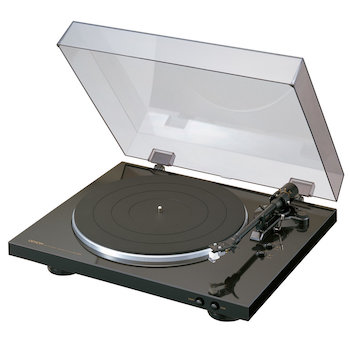 Type: Belt Drive
Type: Belt Drive
Speeds: 33⅓, 45 RPM
Cartridge Included: Yes
Phono Preamp Included: Yes
What We Like: Simple and straightforward to use, with a capable phono preamp.
What We Don't: The cartridge isn’t great, and we recommend buying one of your own.
It’s surprising that Denon's turntable offerings have yet to impress us. They make excellent equipment, so it's a puzzle. But on the face of it, a model like the DP-300F is quite good. It’s designed to compete with something like the Audio-Technica AT-LP120XBT, and it offers a good range of features. These include a very capable phono preamp. We also think it's easier to use than the AT-LP120XBT, with automatic operation.
But it’s the details that cause the DP-300F problems. Denon uses an in-house cartridge that, quite frankly, isn’t very good. If you do go for this turntable, we strongly recommend investing in a cartridge from a manufacturer like Ortofon. It will be of much higher quality, and will vastly improve the sound of this turntable. For now, while the DP-300F is a good alternative, there are better options available.
See the Denon DP-300F
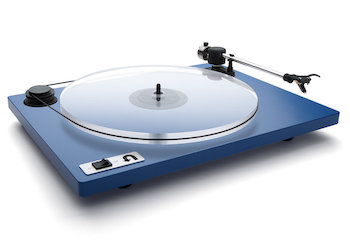 Type: Belt Drive
Type: Belt Drive
Speeds: 33⅓, 45 RPM
Cartridge Included: Yes
Phono Preamp Included: No
What We Like: Enjoyable and exciting sound quality matched by great looks.
What We Don't: Distortion at high volumes, expensive for what you get.
Although far from the best turntable on this list, the U-Turn Audio Orbit Plus has some of the best sound of any model here. It’s exciting, trading realism and balance for a sound signature that brims with life. And while the feature set is a little barebones, there’s no denying that the Orbit Plus looks great.
And on that note: there is no getting away from the fact that the Orbit Plus is pretty pricey. Normally this isn’t a problem, but you don’t get a huge array of features here. There is no USB out, only two speeds, and if you want to add a phono preamp, you’ll need to pay extra. We also weren’t fans of the slight distortion we noticed at high volumes. The Orbit Plus is definitely a contender, and a worthy alternative to models like the Marantz TT42, but it does have some issues.
See the U-Turn Audio Orbit Plus
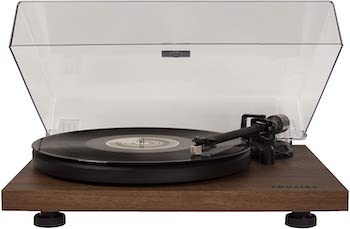 Type: Belt Drive
Type: Belt Drive
Speeds: 33⅓, 45 RPM
Cartridge Included: Yes
Phono Preamp Included: Yes
What We Like: Delightful looks and simple operation.
What We Don't: Poor included phono preamp can distort at high volumes.
Crosley often gets a bad rap in hard-core turntable circles. It’s a good thing we are not part of a hardcore turntable circle. In our opinion, the Crosley C6 is dramatically better than the online hate might suggest. For a very reasonable price, you get a turntable that not only offers deliciously clean looks, but is simple to operate and sounds great. Matched up against the Audio-Technica AT-LP120, the audio quality isn’t as good. But the looks are very much superior, as is the beautifully simple ease-of-use.
The C6 comes with a built-in phono preamp which allows connection to just about any hi-fi system. Unfortunately, that preamp does have problems, distorting at high volumes. It’s a frustrating black mark against a turntable that genuinely surprised us. If you want something with a little bit more style and pizzazz than the Audio-Technica, but you’re not willing to compromise on features, go for the C6.
See the Crosley C6
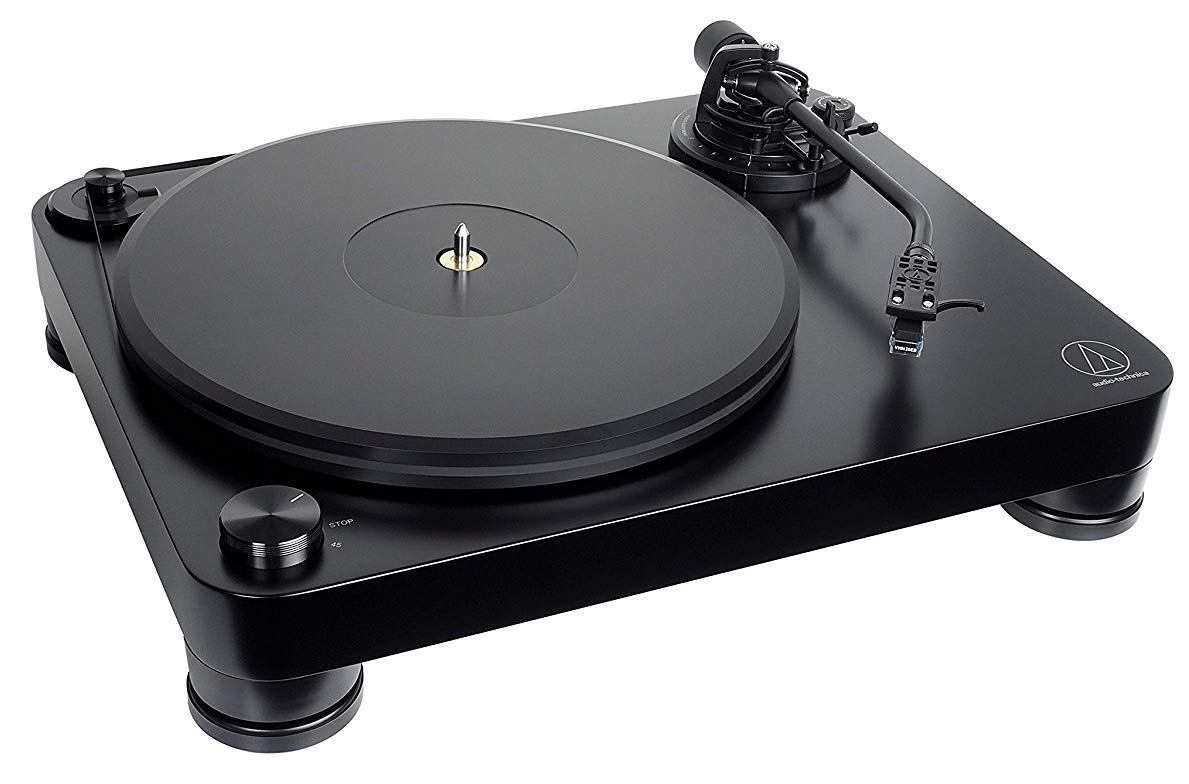 Type: Belt Drive
Type: Belt Drive
Speeds: 33⅓, 45 RPM
Cartridge Included: Yes
Phono Preamp Included: Yes
What We Like: Solid and reliable, great value for money, excellent sound.
What We Don't: The AT-LP7 offers two speeds only.
It’s hardly surprising that Audio-Technica have multiple models on this list—they know what they are doing. Two of their more affordable models already dominate the top spots, but they make relatively high-end turntables as well, and the AT-LP7 is worth looking at for anybody who wants stellar sound with tried-and-trusted design. Audio Technica has solved the common belt drive system problem of inconsistent playback speed, by including a highly accurate speed sensor. The company's signature J-shaped tonearm features a gimbal suspension and precision bearings that minimize playback errors. Its built-in phono stage, unusually, has a switch to cater for Moving Magnet and Moving Coil cartridge types as well as a switchable Phono/Line Out option. In other words: tons of features, matched with killer sound.
The Clearaudio and Pro-Ject models, below, still manage to offer a bit more in terms of overall performance, and the Cambridge Audio Alva TT (above) sounds significantly better. We should also say that some features are missing here that we expected to see, like a USB out. That means the AT-LP7 isn’t a good choice for those who want to digitize their vinyl collection. For that, you may want to look at an inexpensive option like the Sony PS-LX310BT
See the Audio-Technica AT-LP7
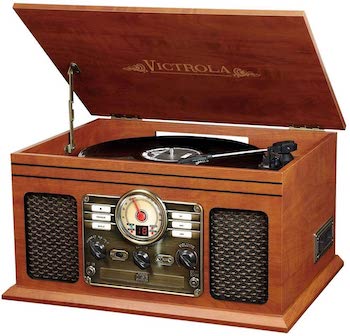 Type: Belt Drive
Type: Belt Drive
Speeds: 33⅓, 45, 78 RPM
Cartridge Included: Yes
Phono Preamp Included: No
What We Like: Plentiful features in a hugely attractive package.
What We Don't: We have serious questions about reliability.
There’s a huge demand for vintage-design turntables at the moment, and there’s no question that the Victrola Nostalgic absolutely nails the looks. Just check out that front panel! This is an all-in-one solution that offers not only vinyl playback, but also Bluetooth audio, a full set of speakers, and an AM/FM radio. Sound quality is good, if unspectacular, and although this isn’t the best vintage turntable here—that would go to another Victrola model, the $50 Journey—it does an excellent job.
We do, however, have serious questions about reliability. The Nostalgic only comes with a 90-day limited warranty. Compare that to the Audio-Technica AT-LP60X, which may not have as many bells and whistles, but is attached to a warranty that lasts up to two years. And while we’ve never had a Nostalgic break on us, there’s no question that the material and construction are very budget indeed. If you demand reliability, the Nostalgic is not the model to buy.
See the Victrola Nostalgic
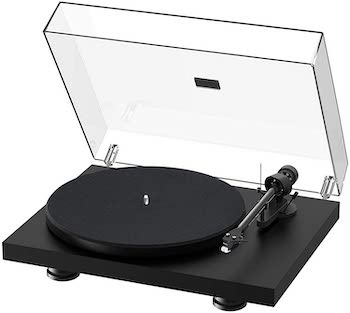 Type: Belt Drive
Type: Belt Drive
Speeds: 33⅓, 45 RPM
Cartridge Included: Yes
Phono Preamp Included: No
What We Like: Solid performance with one of the best tonearms we’ve used.
What We Don't: Barebone design which might be initially puzzling
The original Pro-Ject Debut turntable was released last century, and the Debut Carbon Evo is perhaps the biggest leap forward yet— albeit one with a significant price tag. The new version adds an Ortofon cartridge and a new motor design, and there’s no question that it sounds terrific. In fact, this may be one of the best-performing turntables under $500, and while we think models from Audio-Technica our better option for most people, the Pro-Ject turntable is ideal if you have a little more cash to spend.
The most glaring downside with the Pro-Ject Debut Carbon Evo, outside of the sizable price tag, is the design. We’ll be honest: we’ve never really liked the design of the Debut series, and it hasn’t improved here. It’s barebones and even a little clunky, and there are better-looking models out there, like those from U-Turn. Get past that, however, and you’ll find a highly capable turntable with supremely detailed sound.
See the Pro-Ject Debut Carbon Evo
 Type: Belt Drive
Type: Belt Drive
Speeds: 33⅓, 45, 78 RPM
Cartridge Included: Yes
Phono Preamp Included: No
What We Like: Superlative looks and sound, plug-and-play design.
What We Don't: Price range puts it out of reach for most.
It's not just that the Clearaudio Concept sounds good. Of course it does—that's part of the reason you're paying $1,800. It's that it offers an absolutely superb experience, including hassle-free plug-and-play design that means you can slot it into just about any existing system. The Clearaudio Verify tonearm plays a big part in the overall performance—it has a magnetic bearing, and its base is made of aluminum with a wood core that guarantees minimal vibrations. It's incredibly easy to set up—as we mentioned, this is highly unusual for a turntable in its price range, which most often caters to professionals.
Supplied with a high-grade performance cartridge, the Concept's sound is splendid, with rich but not overpowering bass and a level of detail that screams for you to dig out the gems from your vinyl collection and get playing. While it may be a little bit expensive for most people, there's no question that this is one of the finest turntables available today, and if you have the money, you should definitely get it.
See the Clearaudio Concept
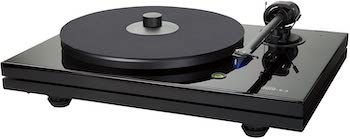 Type: Belt Drive
Type: Belt Drive
Speeds: 33⅓, 45, 78 RPM
Cartridge Included: Yes
Phono Preamp Included: No
What We Like: Ultra-quiet operation with solid sound quality.
What We Don't: Poor anti-skate mechanism does not allow for fine adjustments.
Music Hall are a company we are very skeptical about, after they were caught rebranding a competitor’s products and passing them off as their own at a higher price. Quite frankly, it's surprising that they went there because they make some remarkable products, including the mmf-5.3 turntable (which, we should point out, we have heard nothing suspicious about_. It’s an excellent turntable, and while it might not have a killer feature to put it above something like the Clearaudio Concept, above, it’s also far more affordable and includes an Ortofon 2M Blue cartridge. We especially enjoyed the ultra-quiet operation, which meant the motor didn’t get in the way of the music.
One big criticism is that the anti-skate control felt imprecise and clunky, and it left us with the feeling that we weren’t fully in control of our music. That’s a shame, given the standard of these types of controls on the rest of the turntables on this list. It’s a double shame, given how expensive the mmf-5.3 turntable is. It’s still a worthy entry on this list, and a good alternative for those who don’t want to spend quite as much is something like the Clearaudio Concept demands, but proceed with caution.
See the Music Hall mmf-5.3
 Type: Belt Drive
Type: Belt Drive
Speeds: 33⅓, 45 RPM
Cartridge Included: Yes
Phono Preamp Included: Yes
What We Like: Gorgeous design, weighty sound.
What We Don't: Outside of the sleek looks, this isn't a particularly special turntable.
If we awarded prizes for looks, then the Fluance RT81 would take it every single year. God, this turntable looks magnificent. For a $250 platter, we didn't expect this level of attention to detail, or a design that seems to blend old-school charm with a highly robust finish. It has a good range of features, too, with a built-in phono stage and a respectable cartridge. There's no USB out, but it's a minor problem.
A bigger issue is the fact that outside of the looks, the RT81 doesn't do anything that other turntables in the same price range don't do. Take, for example, the top-ranked Audio-Technica AT-LP120. That turntable is less expensive—just under $21 less at the time of writing—but it sounds much better, with more dynamic audio. That doesn't mean the RT81 should be overlooked, but it isn't the first choice. If this is your budget, then think carefully about how much looks mean to you.
See the Fluance RT81
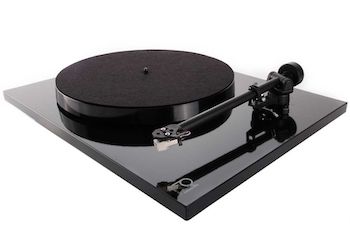 Type: Belt Drive
Type: Belt Drive
Speeds: 33⅓, 45 RPM
Cartridge Included: Yes
Phono Preamp Included: No
What We Like: Incredibly easy to set up and use, rhythmic and enjoyable sound quality.
What We Don't: No longer the best available.
The Rega Planar 1 had a huge amount of hype when it came out, viewed as a giant-killer. While we don’t think it’s quite that impressive, it’s still a very good turntable. It’s arguably one of the easiest to set up and use, comparable with the Audio-Technica AT-LP60X, which sets the bar here. The rhythmic and pacey sound quality gives new life to music you’ve heard a thousand times already, and we think there’s an argument for the Planar 1 sounding even better than the Marantz TT42, a turntable devoted to great sound.
That being said, while we can see why others love the Planar 1, we think there are better options available. The Audio-Technica AT-LP120XBT is less expensive, offers better features off the bat (including a phono preamp) and will be a better option for most people. Worth noting: Rega do make an option that does include a phono preamp, the Planar 1 Plus, but we’ve seen its availability fluctuate. It’s also significantly more expensive.
See the Rega Planar 1
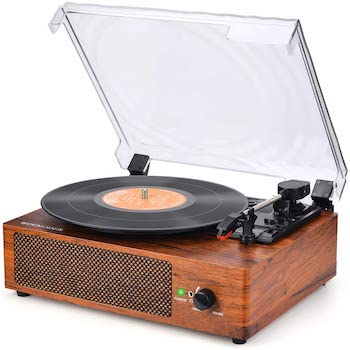 Type: Belt Drive
Type: Belt Drive
Speeds: 33⅓, 45, 78 RPM
Cartridge Included: Yes
Phono Preamp Included: No
What We Like: Lovely looks and useful features.
What We Don't: Some real issues with sound quality.
Like the Victrolas, above, the WOCKODER Record Player is a vintage turntable—or designed to resemble one, at any rate. Unlike the Victrola Journey, which retails for around the same price, the WOCKODER isn’t portable—there is no handy suitcase design here. What you do get is a genuinely lovely design, with a wooden housing that contains not only a full speaker system, but a range of features including Bluetooth. There are very few budget record players that we’d recommend, but we think the WOCKODER is worth a look.
You may find yourself unimpressed with the sound quality. The turntable itself is perfectly adequate, but the included speaker is very poor indeed. Outside of an included headphone jack, there’s no option to transmit the audio from the turntable to another set of speakers, so unfortunately, you’re stuck with it. This isn’t a problem if you just want a turntable system for casual listening, but if you value sound quality, we recommend other models on this list like the aforementioned Victrolas.
See the WOCKODER Record Player
| Turntable | Price | Type | Speed | Cartridge | Phono* | USB | Weight |
|---|---|---|---|---|---|---|---|
| Audio-Technica AT-LP120XBT | $399 | Direct Drive | 33⅓, 45, 78 | Yes | Yes | Yes | 17.6lbs |
| Audio-Technica AT-LP60X | $149 | Belt Drive | 33⅓, 45 | Yes | No | No | 4.3lbs |
| Rega Planar 3 | $1,395 | Belt Drive | 33⅓, 45 | No | Yes | No | 13.2lbs |
| Sony PS-LX310BT | $248 | Belt Drive | 33⅓, 45 | Yes | Yes | Yes | 7.1lbs |
| Victrola Journey+ | $50 | Belt Drive | 33⅓, 45, 78 | Yes | No | No | 2.69lbs |
| Byron Statics KCT-601 | $49 | Belt Drive | 33⅓, 45, 78 | Yes | No | No | 6.6lbs |
| Denon DP-300F | $429 | Belt Drive | 33⅓, 45 | Yes | Yes | No | 12.13lbs |
| U-Turn Audio Orbit Plus | $299 | Belt Drive | 33⅓, 45 | Yes | No | No | 12.5lbs |
| Crosley C6 | $165 | Belt Drive | 33⅓, 45 | Yes | Yes | No | 12.13lbs |
| Audio-Technica AT-LP7 | $849 | Belt Drive | 33⅓, 45 | Yes | Yes | No | 18.3lbs |
| Victrola Nostalgic | $140 | Belt Drive | 33⅓, 45, 78 | Yes | No | No | 17.64lbs |
| Pro-Ject Debut Carbon Evo | $499 | Belt Drive | 33⅓, 45 | Yes | No | No | 12.35lbs |
| Clearaudio Concept | $1,800 | Belt Drive | 33⅓, 45, 78 | Yes | No | No | 16.5lbs |
| Music Hall mmf-5.3 | $1,199 | Belt Drive | 33⅓, 45, 78 | Yes | No | No | 24lbs |
| Fluance RT81 | $250 | Belt Drive | 33⅓, 45 | Yes | Yes | No | 14.1lbs |
| Rega Planar 1 | $595 | Belt Drive | 33⅓, 45 | Yes | No | No | 9.26lbs |
| WOCKODER Record Player | $44 | Belt Drive | 33⅓, 45, 78 | Yes | No | No | 4.7lbs |
*Phono preamp stage included
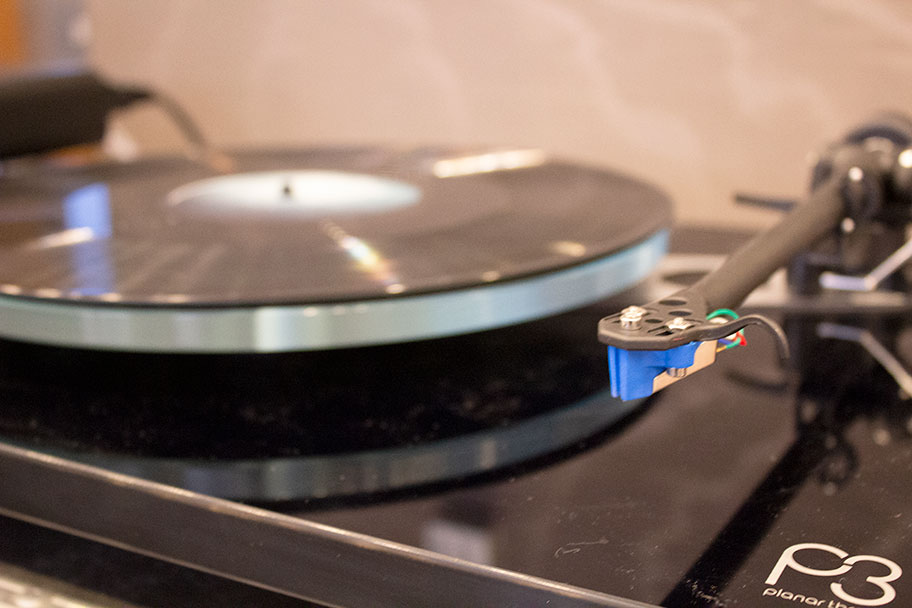
Depending on how they use turntable internal motors to spin the platter at a constant speed, they can be classified into two main types. In a direct drive model, the rotating platter is attached to and spins directly via the electric motor, resulting in a constant and accurate rotation speed, faster playback startup and stronger torque. Higher torque means the platter is less vulnerable to outside vibrations such as the stylus or your hand for instance. Which reminds us of that famed special effect… Yes, scratching - the backward-forward movement used by DJs to create rhythmic sound blasts is so easy to do on direct drives. Check out the Invisbl Skratch Piklz if you want to see this done in a truly mind-blowing fashion... If there are cons with direct drive types, they would relate to possible unwanted vibrations caused by the motor itself, which can affect sound quality. The issue can be addressed with the use of shock absorbers between the platter and the motor.
Belt drive models, on the other hand, spin the platter using an elastic belt that’s attached to the motor. The platter sits on a circular bearing which is separate from the motor. The belt (sort of) resembles a bicycle chain, if you can imagine the bike pedals as the motor and the back wheel as the platter. This system actually absorbs shock and prevents vibrations that are generated by the motor from reaching the platter and being transmitted to the tonearm. That is why audiophiles might prefer belt drives - less noise and less interference often means cleaner sound. Be aware, though - belt drives have much lower torque and can have less accurate playback speed. Plus, the belt can wear down after a few years, and need to be replaced. The good news is that like with pretty much everything these days, spares are easily available online.
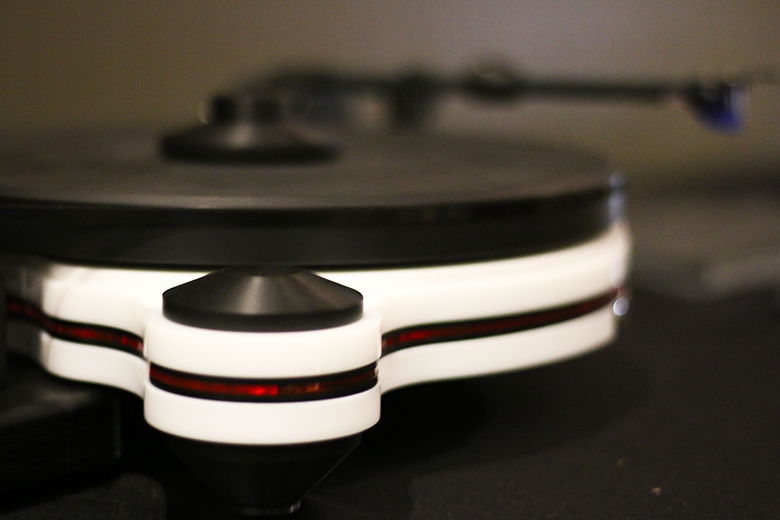
Before we talk about the differences between vintage and modern turntables, we need to clarify something. When we say vintage, we don’t actually mean ‘old’. While there are plenty of decades-old, restored turntables available on sites like eBay, and while they no doubt offer huge thrills for those who use them, we don’t really cover them here. Their maintenance and set up can often be very difficult and technical, and we don’t feel we can talk with authority on the topic.
So when we say vintage, we are talking about the term in the way most people these days would probably think about it. A vintage turntable is one with modern technology, like Bluetooth wireless audio, but with old-school looks that include elements like wood paneling and visible volume meters. As an example, check out the Victrola Nostalgic, which looks like it’s been teleported straight from the 1950s.
If you like the idea of the turntable with vintage design: great! There are many models to choose from, and several we’ve highlighted in the list above (our current pick for the best vintage turntable: the $50 Victrola Journey+, which also happens to be portable). The one thing to bear in mind is that looks are paramount with these turntables, and sound quality is often an afterthought. They frequently include speakers of their own, which may not always be all that good. If you like the idea of a vintage turntable, and are fine with a one-box system, then go for it. But if you have separate hi-fi speakers, or want to include other separates in your system, then you’ll need to make sure that your vintage turntable can output audio.
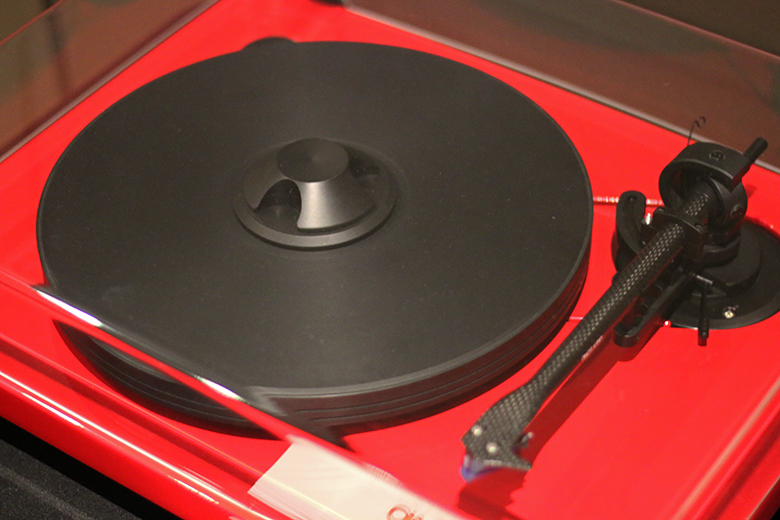
Let's assume, for argument's sake, that you've fully assembled your turntable, in the sense of slotting the platter into place and making sure that any accessories have been connected, with the exception of wires, which we’ll go into below. We are not going to go into cartridge installation here, as that's an entirely different kettle of fish - and has its own section below. We'll also talk about wiring in another section. For now? You just need to do the following things.
First thing to understand about setting up a turntable: it's not about the turntable. If you think this is just a load of Zen nonsense, think again. Turntables won't work if they are unstable or even fractionally angled, so where you put them is crucial. The surface needs to be as flat and solid as possible – a dedicated stand is ideal, like this Crosley ST75-BK, but if you don't want to spring for that, a solid coffee table will work just fine. Once you've got that, check to see if your turntable has adjustable feet. If it does, then use a spirit level to make sure that the surface of the platter is dead-on flat.
Tonearms are actually incredibly important for audio detail. We did promise that we’d discuss only ordinary vinyl setups in this article, but just so you get a sense of why tonearms have ‘tone’ in their name, vinyl enthusiasts can go to extreme lengths in obtaining the very best sonic detail.
Back to Earth now: let’s take a look at your tonearm. As long as you don't have one of those most basic turntables, chances are you'll be able to make some adjustments to its tonearm. This is absolutely crucial to getting the best sound from your vinyl, so it's worth taking a little bit of time on it. The first thing you want to do is see if your turntable has an anti-skating knob. We’ll talk about anti-skating below, but if it does have this knob, set it to zero.
Now: time to adjust the counterweight, which will help the arm balance itself effectively, and sit well in the groove of the record. This is known as the Tracking Weight, and (usually), it’s adjusted by turning the big, circular weight on the back of the tonearm itself. As a general rule, you want it set so that when the tonearm floats freely, it more or less balances, and rides flat. Pop it out of its stand, and adjust the weight until you get this. OK - see the little gauge at the front of the weight? Adjust it until it's zeroed - what is known as zero weight. Now you need to turn the big weight again, and this is where you need to pull out the manual that came with your cartridge – or your turntable if the cartridge came pre-supplied. The manufacturer will have listed a number in grams. Don't stress if it gives a range – just set it so that the weight is roughly in the middle of that range.
Congratulations. You have your tracking weight. Have a drink.
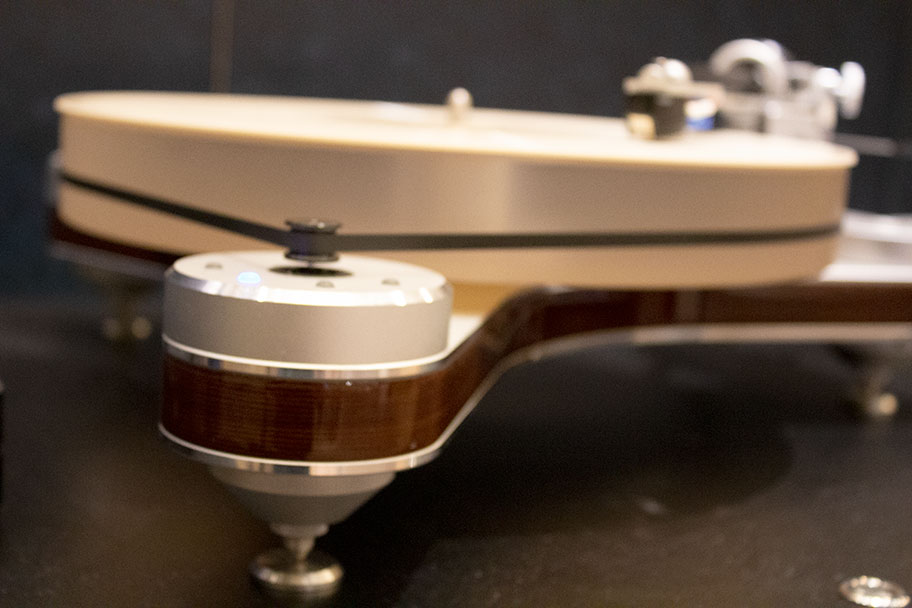
Well, maybe not yet. We've still got a few more things to do. One of those is to set the anti-skate knob. This will stop the stylus from being pulled into the center of the record as it spins. Super important: it’s sometimes referred to as bias. Find the knob, then turn it to match the tracking weight. Maybe a quarter-gram less, which is what most experts recommend.
Not all turntables have this. It helps keep an even pressure in the groove. If your turntable has it (some Rega models do) then all you need to do is check the manual. The manufacturer should recommend a specific setting.
This refers to how perpendicular the stylus is to the actual record – obviously, the more, the better. If the azimuth is slightly off, it can mess with the soundstage. Now we'll be honest: correcting the azimuth is a pain in the neck. It not only requires a level of technical knowledge that can sometimes be a little daunting, but to get exactly right, you need a mono test record as well as an expensive range meter like the Fozgometer, which can hit $300. Based on that, we've decided not to go into it here; for most people, simply getting the above steps right will result in excellent sound, and although adjusting the azimuth will have an impact, it requires an investment of time that we don't think is 100% necessary (audiophiles, please leave curse words out of your comments below, thank you).
If you do want to check out how to do it, there's an excellent guide right here.
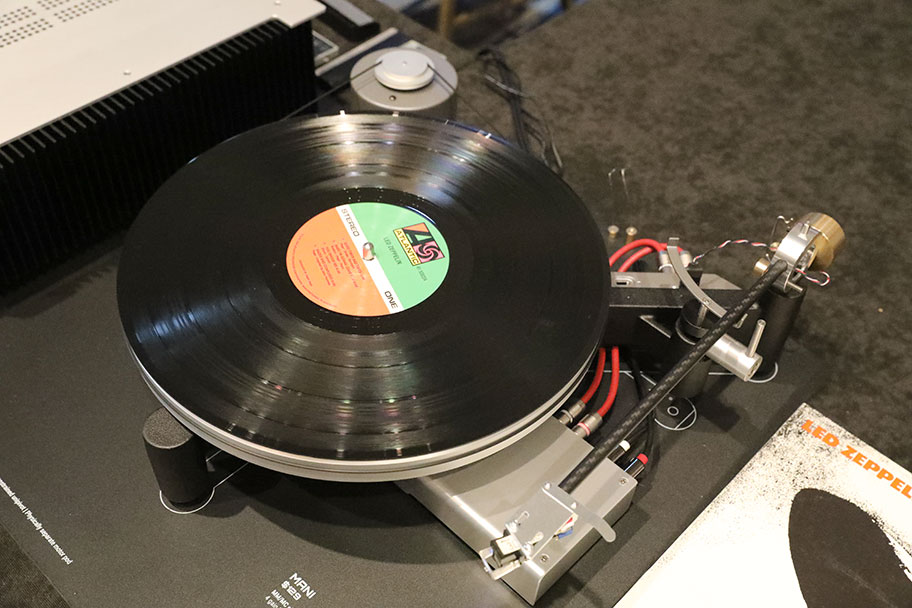
When you think about it, a turntable is remarkable. It uses a tiny needle to read infinitesimal grooves on a spinning wax disc, and convert them into audio signals. The thing is, we can’t actually hear those audio signals. That’s because at the turntable stage, they are virtually inaudible. A needle may be able to pick up the grooves in a record perfectly, but it needs a lot of help to amplify the sound so we can actually hear it. That’s where phono preamps come in.
Phono preamps do two things. They amplify the signal, boosting it to the point where we will be able to hear it. It will need further boosting from a dedicated hi-fi amplifier further down the track, but that’s a separate issue—for now, what you need to know is that a phono preamp will get the signal to audible levels. The second thing is that they equalize the sound. The translation from a wax disc leaves the audio sounding very muffled, and it is the job of the phono preamp to smooth this out and make sure that you can hear the highs as well as the lows. A good phono preamp can really supercharge your system, and coincidentally, we have a list of the very best here.
You may not actually need to buy a separate phono preamp. That’s because many turntables come with one included, meaning all you need to do is connect them directly to your speaker amplifier. Models like the top-ranked Audio-Technica AT-LP120XBT have a very capable phono preamps built in. Be warned: a model may not allow you to add an external phono preamp into the mix, so if you plan to, be sure to check that the turntable allows this
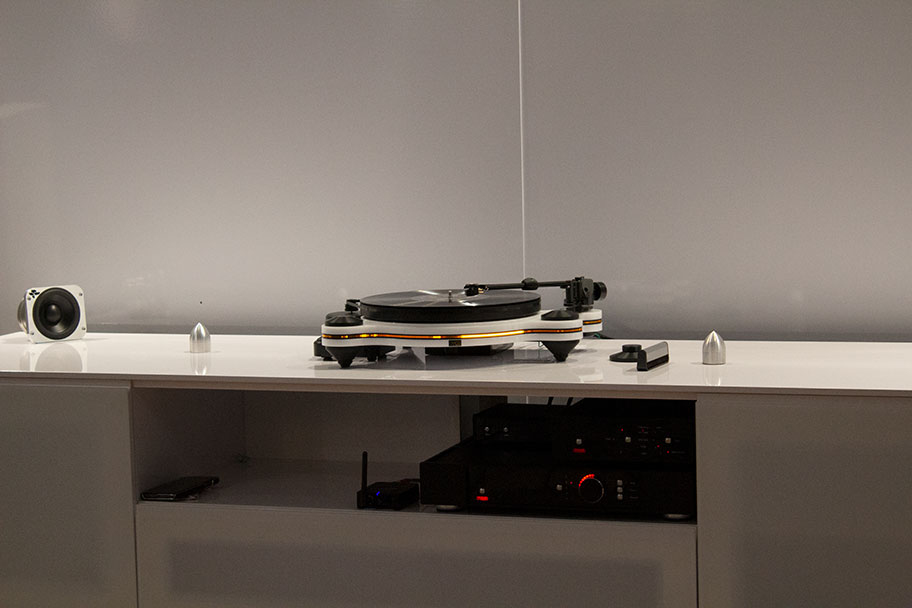
The cartridge is the little piece of plastic-encased electronics at the front of the tonearm. It helps the stylus - the needle - convert the mini-vibrations from tracking the vinyl grooves into sound. The cartridge itself is installed in a headshell - think a tiny, plastic mounting bracket. When we say cartridge, though, we mean the whole package, including the stylus.
Budget cartridges can often be characterized by their somewhat thin and weedy sound, while expensive ones (some of which fetch four-figure prices) can often challenge and even outperform CD audio quality. They are an enigmatic and often difficult type of audio kit. Similar to headphones and microphones, different makes can have a more gutsy and fuller-sounding audio playback, while better-quality replacements also guarantee better groove tracking and skip-free performance. This means that vinyl lovers are in luck, since headshells, cartridges, and styli are all parts which can be changed, replaced, or upgraded.
For real vinyl enthusiasts, this is a good place to say that there are two main types of vinyl cartridges - MM and MC. More often than not you will see turntable specs including an MM cartridge, which stands for Moving Magnet. The other type of cartridge you will see is MC, which stands for Moving Coil and both of these names are a reference to the components within the cartridge that help to convert the stylus movements into electromagnetic signals. To simplify things, it is easy to think of MM (Moving Magnet) cartridges as the ‘regular’ type as they are supplied with the majority of commercial production turntables. They are heavier and with a higher output, feature replaceable needles, and are well matched with the phono preamps found in hi-fi equipment such as regular A/V receivers.
MC (Moving Coil) cartridges, on the other hand, are generally referred to as the more boutique type, favored by vinyl purists. They predate MM carts historically and are physically lighter, meaning that they can track the record grooves with a much higher precision - their biggest advantage really, resulting in super-accurate frequency representation. Being lighter also means that they tend to skip easier than MMs, though the main difficulty with MC carts is their extremely low output, which necessitates the use of ‘proper’ phono preamps especially equipped for receiving and amplifying MC cartridge signals. This combo (MC cartridge and a dedicated phono stage) is arguably the first serious step toward an audiophile-grade vinyl setup.
Since this is firmly into geek territory, we might as well mention the MI cartridge - moving iron, which is a variation of the moving magnet type at present - and one more, HOMC, which stands for high output moving coil. But the big ones for you to remember are MM and MC.
Regardless of its type, installing a cartridge is fairly straightforward, if a bit fiddly. You need an appropriately-sized screwdriver (we trust you know how screws work), and you need to attach the color-coded wires sprouting from the tonearm into the correct spots. Confused? Here’s Youtube being put to a good use for you - there are plenty of videos explaining in detail how to attach a cartridge to a headshell.
It also really, really helps if you have a cartridge alignment gauge, as even small adjustments can make a real difference. We are not going to lie: setting up and properly calibrating a cartridge can be a giant pain in the backside and can involve some pretty exacting measurements. It's a little weighty for our purposes, but if you do want to get involved with this – well, more power to you, and you can find a very solid guide to doing it here. It should be said that there are some great pro-level packages (as in, integrated headshells with a cartridge and a stylus) such as the Numark CC-1, Ortofon Concorde, or Stanton Groovemaster, which are ready to be popped at the end of your tonearm without any hassle.
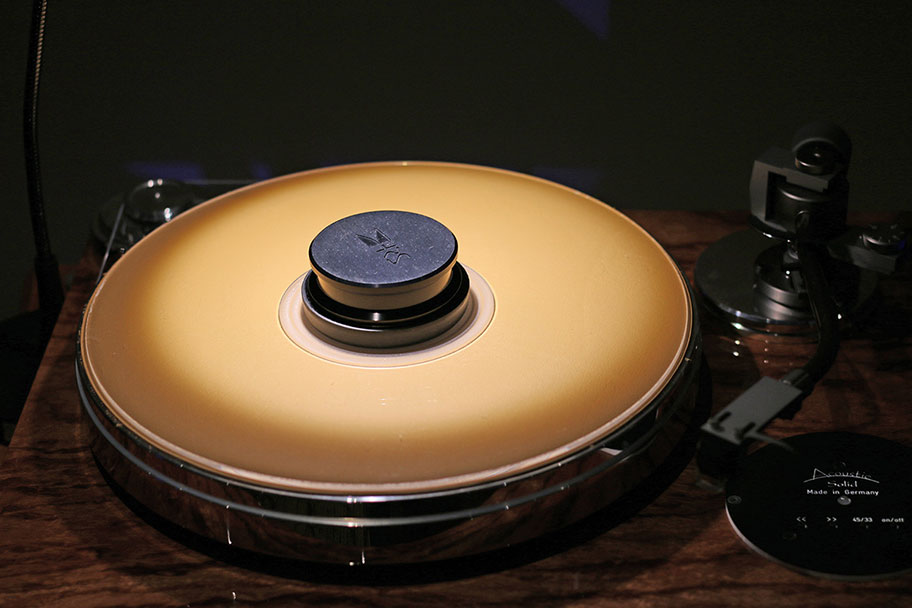
Vinyl records are manufactured in three commonly universal speed formats: 33⅓, 45, and 78 RPM, which stands for rotation (or revolution)-per-minute. This of course means that faster formats last less and can fit shorter recording durations (subject to the record’s physical size as well). Historically speaking, 78 RPM releases were the first commercial variety, though currently they are fairly rare. What you’ll mostly be dealing with is 33⅓ and 45 RPM standards.
RPM speeds really do make a difference. The vinyl record grooves’ ability to capture sonic detail is proportionate to the RPM figure. A bit like imagining a pencil drawing - the denser the lines, the more detail, which when applied to the sonic attributes of vinyl records translates into more punch (vinyl talk for transient attack detail) and better capture of the crucial mid-frequency bands. This is also the reason why you might find that 45 and 78 releases are often of spoken word, classical music, or Frank Sinatra’s newest (OK, back in 1946) smash hit single. Things do sound better when spun faster, simply on account of the denser detail captured in those record grooves.
Give us a reason why a turntable should not have a Bluetooth signal. You can’t. It’s impossible. The ability for a turntable to transmit wirelessly when called upon can be hugely useful. It can simplify your hi-fi system, meaning you require fewer components. It can allow you to listen to your vinyl on wireless headphones or wireless speakers. And thanks to advanced Bluetooth technology like aptX, you’ll get some quality that is almost as good as wired sound, and the difference will be so slight as to be effectively unimportant. We recognize that this statement may annoy hardcore audiophiles, but the fact is: wireless audio is here to stay, and it can very often be brilliant.
However, we would say that if you do want a turntable with Bluetooth, it’s worth spending a little time looking at turntables that specialize in it. You want it to be a fully fleshed-out feature, rather than one that has just been tacked on. That’s why we recommend going for a turntable like the $198 Sony PS-LX310BT, which we currently have ranked as the best wireless turntable. It not only offers Bluetooth 4.2, which is the current industry standard, but it also offers aptX—a special type of transmission that boosts the audio quality even further. All you need to take advantage of it is a wireless speaker or pair of headphones that are able to use it. By looking for features like Bluetooth 4.2, aptX, and aptX HD, you’re guaranteed a brilliant wireless experience.
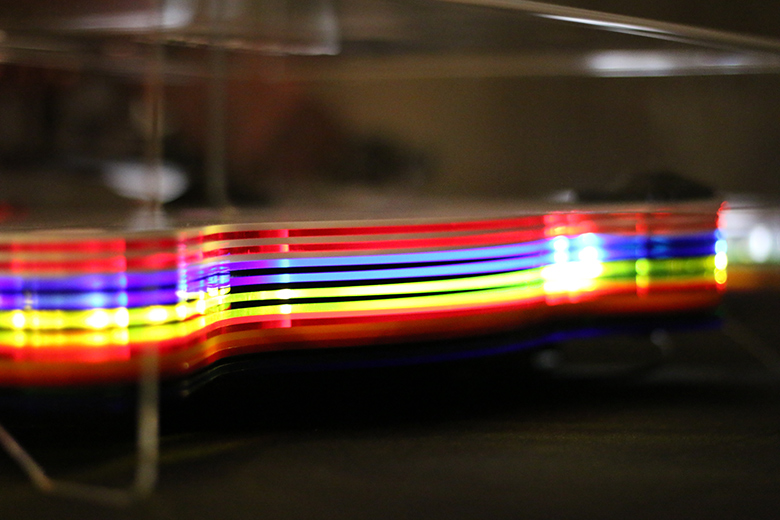
Vintage gear was designed to be heavy and steady - from the floor-mounted speakers to the proverbial tank-proof Technics 1210s. Turntable weight is an important sonic factor, but the reason for this might be a bit surprising to many. Gravity affects vinyl playback in multiple ways: the turntable’s feet/chassis, the record itself, and the tonearm and stylus. We already stressed the importance of using absolutely flat surfaces and stands - adjusting the feet as to minimize vertical vinyl movement is paramount. Weightier turntables naturally minimize (or get rid of) chassis vibrations, especially when positioned near speakers producing deep bass harmonics, so yeah, the heavier the better.
Similarly, the weight of the record itself is very important for that skip-free continuous playback, and 120-140g (yep, weirdly this is in metric grams) vinyl is the standard weight for modern LP releases. With the current vinyl renaissance though, heavier vinyl such as 180g has become associated with audiophile quality - these records are considered less prone to jumps. Some even argue that they have slightly better soundstage and stereo imaging, though this depends on many other factors such as mastering, manufacturing, and materials.
One potentially very helpful tip would be about using the so-called record clamps (check this fine example). These have many benefits, especially when a record or a turntable weight might be an issue (we mean not enough of it). Not only do they couple the record firmly to the platter, minimizing warping and tilting, but they also free the stylus from unwanted internal resonances, sympathetic vibrations, and harmonics. The resulting effect is as if the record is of higher rigidity, thickness, and weight.
You’ll notice in our list above that we’ve talked about some turntables as being automatic, and some as being manual. The difference is quite simple. With a manual turntable, you’ll need to set the record spinning by turning the player on, then manually lift and place the tonearm so that the needle makes contact with the groove. Semiautomatic turntables, which are not very common, require you to do this but will lift the needle off when the record ends. Automatic turntables on the other hand do it all for you. They will automatically raise and lower the tonearm, finding the groove without your input.
The benefits of an automatic turntable are pretty obvious. They are incredibly easy to use, requiring little to no knowledge. All you have to do is push a button. It used to be that automatic turntables were super expensive, but the technology has advanced to the point that even our top budget turntable, the $119 Audio-Technica AT-LP60X, is fully automatic. The downside is that this automation requires additional circuitry, which can mess with the sound quality. Manual turntables may be a little trickier to use, but you are usually guaranteed improved sound, as there are fewer components involved in the process. As with all audio choices, this is a trade-off between convenience and quality. Which side you come down on is entirely up to you.

This might make a vinyl enthusiast frown, but some people like to digitize their vinyl collections. Nothing wrong with that - vinyl is big and cumbersome, and it’s always handy to have a digital backup. Many current consumer-grade record players may now include a USB port built in and that of course makes things extra easy. There is an element of varying quality to built-in USB audio interfaces, however - more expensive units can offer a much better subjective audio detail. It is all down to the A/D converter chipset (also known as DAC) used by manufacturers, and if this term puzzles you slightly, we have more detailed info on DACs here.
Similar to the phono-to-line preamps available on the market, you can also find phono-to-USB boxes: palm-sized devices that will patch your turntable to a computer. The normally included basic audio editing program would allow you to trim the beginnings and endings of the digitized recordings and even repair some of the hiss and crackle.
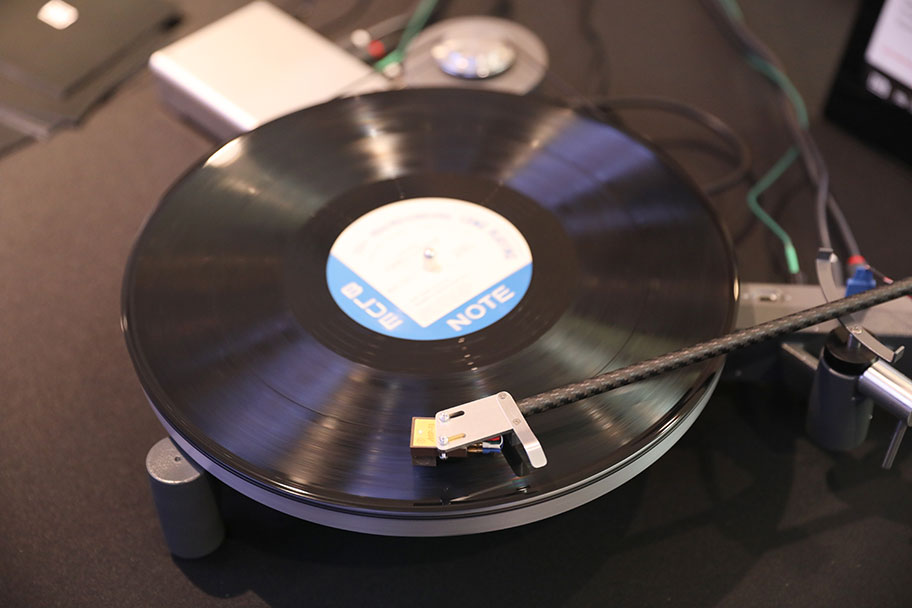
Unlike a lot of electronic equipment, turntables require a little bit of maintenance. The physical interaction between the stylus and the grooves on the record means that a lot of things – from vibrations to dirt and dust – can cause things to go out of whack over time. Think of the turntable like a muscle. If a small injury is ignored, it can often develop into a bigger problem further down the line. It’s far easier to spend a little bit of time taking care of that muscle and stopping small problems from becoming big ones. Although this is viewed as a little bit of a dark art, it doesn’t have to be. There are a couple of simple things you can do to keep your turntable in excellent working order.
The first is to simply make sure that it’s free from vibrations. Most turntables take this into account, providing a good level of stability for the platter, but when that’s not the case – or when the turntable is in an area with high foot traffic – then you might want to consider investing in a couple of acoustic feet, to shield the platter from vibrations. Also, protip: check things with a spirit level to make sure that the platter is absolutely flat. You will be surprised at how many turntables are not a hundred percent level, even when placed on what appears to be a flat surface.
Second thing? Keep it out of sunlight, and give it a good clean now and then. A stylus brush (Clearaudio make an excellent one) can help keep dirt off the needle.
Third, regularly check back on things like the tonearm weight, height, and anti-skate. Setting these correctly at the start, as described above, will nullify almost all maintenance problems with your turntable, and regularly making sure that they are all okay (as well as checking to see if any parts, like the belt, need replacing) will go a long way to keeping things running smooth.
Most turntables require a slipmat, which is a circular piece of cork or fabric designed to be placed between the record and the turntable; both record and slipmat will slot straight onto the platter. They have several distinct advantages, including protecting the record from the actual platter itself. If you're a DJ, they help eliminate friction. And of course, as with any bit of audio equipment, there is just one to choose from. You can buy cork slipmats, which audiophiles swear by due to their resonant quality, or you can go for a standard rubber mat, which will vastly reduce vibrations – extremely helpful if you have a slightly unstable listening surface, or if you don't trust your turntable's stabilizers.